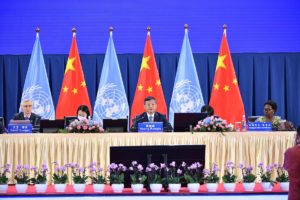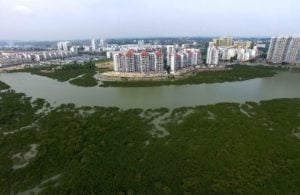For many, last month’s UN climate change conference (COP26) in the UK was a disappointment. Although negotiators were able to reach agreement on the Glasgow Climate Pact, UN Secretary General António Guterres called it a compromise that leaves us “still knocking on the door of climate catastrophe”.
Nevertheless, there were areas of progress. Among them was the greater prominence given to food, nature and biodiversity than at previous COPs. This reflects another crucial set of meetings that started in October in the city of Kunming, southwest China: the UN biodiversity conference (COP15). It also reflects growing awareness that the twin global crises of climate change and biodiversity loss are intrinsically linked, as efforts to tackle them must also be.
In this webinar, jointly hosted by China Dialogue and the Robert Bosch Stiftung on 3 December, our panellists explored these interconnections. They laid out their main recommendations for tackling biodiversity loss, through spatial planning, finance and the involvement of indigenous peoples and local communities, and explained how China can set a leading example in the global effort to protect and restore the natural world.
Speakers:
Sam Geall (chair) – China Dialogue
Gerrit Hansen – Robert Bosch Stiftung
Guo Li – Lau China Institute, King’s College London
Li Lin – WWF International
Guido Schmidt-Traub – SYSTEMIQ
Some interesting excerpts
Sam Geall:
00:46: Global problems – from ocean conservation to climate change, or from tax havens to debt relief – require global solutions. The pandemic has illustrated this very vividly: how international cooperation, action and ambition can be obstructed by competition, by suspicion, by protectionism; and how costly the results of those failures can be. It’s [also] evident from Covid-19 that when individual nations hoard vaccines or fail to share information internationally, global efforts to exit the pandemic, or at least to better manage its consequences, are harmed. Just as achieving coordination and leadership is needed for that [pandemic] exit strategy and for the economic recovery, this is needed too for climate change and for the protection of the natural world. We’ve seen how fragmentation across multiple globalised systems means that stresses and shocks can risk cascading negative effects… Climate change and the destruction of the natural world present similar risks. Just as failure to act within one system can obstruct action within others, we can also find positive interplays by coordinating across systems, by creating virtuous circles and by strengthening action in one policy goal in order to strengthen the likely achievement of other goals, rather than to create trade-offs. Climate change and nature is one of those potential synergies.
03:14: If we want to see progress in saving the natural world, we’re going to need to see increased action on climate change. And if we want to have any kind of hope of really working on climate change, we’re going to need to see real scaling up of ambition to protect the natural world, for so-called “nature-based solutions” to get anywhere close to achieving what we need in terms of reaching carbon neutrality by mid-century.
54:54: For China, this is about national self-interest. There is a strong element, as with climate, about China understanding its own economic risks [and] the political-economic reasons to protect nature, as much as any kind of issue of international cooperation or standing.
Gerrit Hansen:
06:15: In Glasgow, there was definitely more talk of nature and nature-based solutions, and specifically the role of indigenous peoples and local communities as stewards of biodiversity and land, than at any other climate summit. The Glasgow Leaders’ Declaration on Forest and Land Use was the first really big announcement that came out of the high-level summit, which is in itself quite significant. Of course, pledging to end deforestation by 2030 is not exactly a new idea, and also, if I may say, not really sufficient. But what makes me hopeful this time around is not so much the impressive list of more than 100 signatory countries, or the serious financial pledges of US$19 billion, including from private sector and philanthropy actors such as the Bezos Earth Fund and the Leaf Coalition, it’s more the fact that this time, in parallel, the UK designed several processes that actually address the root cause of deforestation and also biodiversity destruction, which is large-scale industrial agriculture. That happened most prominently through the so-called FACT Dialogue, which was co-led by Indonesia and is a partnership by the key producer and consumer countries of forest-risk commodities. And a partnership to axe deforestation from their supply chains and invest in sustainably produced commodities and trade.
08:01: Another important signal was the commitment from 30 financial institutions to eliminate investments linked to deforestation by 2025. Finance ministers and central banks are recognising the need for financial institutions to disclose the scale of their investments linked to deforestation. This kind of financial disclosure is proving to be a very powerful instrument for decarbonisation in other sectors, and I think that including deforestation explicitly may actually go a long way to move from national-level declarations to actual action by the corporations in charge of most of the forest-risk commodities.
09:21: The term “nature-based solutions”, which has been an integral part of the UK’s nature campaign for the last two years, was deleted from the final text [of the Glasgow Climate Pact] and replaced by “the critical role of protecting, conserving and restoring nature and ecosystems [in] delivering benefits for climate adaptation and mitigation”. This wording is less open to misappropriation, and therefore probably more useful moving forward… So I’d be cautiously optimistic that COP26 has to some extent led to a rise in awareness of how crucial nature is for climate resilience and mitigation, how intrinsically interlinked the biodiversity and climate crisis are, and that the role of nature-based solutions – if I may still call them that – is not to provide offsets, but to stabilise and safeguard the health of our planet.
1:01:46: Yes, we need a global goal that can be implemented – to have your guiding star, as we have with Paris… I think recognition of spatial planning, as Guido has so eloquently explained, is really crucial and should be very prominent, because without that, we will never get to the meaningful implementation needed on the climate nor the biodiversity side. And then the third thing, which I think is really crucial, is that we need to resolve the tensions around the 30×30 target, the concerns coming from the indigenous communities, local peoples [and] human rights communities. And make sure that we design a framework in a way that does not only recognise the needs of the local populations, but also their contributions, and that makes sure that, as Li Lin also said before, it’s not about fencing some area somewhere – and then we have the 30%, and then we do whatever with the rest – but that we really move towards a more sound, integrated, ecologically oriented society at large.
Li Lin:
13:18: COP15, although it didn’t have the ambition we need, or [use] clear global biodiversity framework language, it does point in the right direction. And especially China, when it assumed its presidency, it showed leadership by [creating] the Kunming Biodiversity Fund. So COP15 Part 1 [has set] a good direction of travel. And in the Kunming Declaration, some of the elements, for example, striking for reversed biodiversity loss by at least 2030, are good. And it talks about mobilising financial resources and about implementation mechanisms. The Kunming Declaration [also] consulted with ministers – not only with environment ministers, but with [those responsible for] finance, agriculture and the economy. So that is a good sign that biodiversity is [entering] the mainstream.
15:22: [There] is elevated attention and commitment to nature. If you also look before COP26, you may notice the Leaders’ Pledge for Nature, and [there are] now 95 heads of state committed to that. We also saw the Leaders’ Pledge for Nature, the High Ambition Coalition for Nature and People, and the Global Ocean Alliance jointly call [in September] for more elevated ambition. That accounts for about 40-something percent of [global] GDP and 30% of the [world’s] population. So you can see that the political commitment is elevated.
16:54: But a gap still exists. If you compare the high-level global commitment to what is currently in the draft Global Biodiversity Framework (GBF), you can see the gap between the commitment and what decisions [will be made] at COP15… We need to work together to really bridge that gap, or narrow that gap between the political commitment made by heads of state, so that they can translate that commitment into the GBF, so that this framework can really guide us to a 2030 where we see a nature-positive world.
38:33: With 30×30, what we at WWF are advocating is that we need to protect the best 30% [that is] critical for ecological services and functions. That doesn’t mean just the rest we just grab. We have to restore what we’ve lost, and then sustainably manage the rest. So the whole planet has to be sustainably managed.
39:06: We’re facing a few challenges. One is, how can we recognise the rights of indigenous people in conservation. In global negotiations, [we] talk about “other effective conservation measures” (OECMs), and that includes IPLCs (indigenous peoples and local communities) who manage the land. The key point here is that governments need to recognise the rights of IPLCs so that the land that is managed sustainably by IPLCs will be counted as OECMs, [and included] within the 30%.
42:01: Spatial planning conservation alone doesn’t give the nature-positive world we need, because if we don’t address the drivers behind biodiversity loss, if we don’t address the footprint, [wherever] you have put conservation in place could be encroached, could be fragmented. And then you cannot… provide the health and integrity of ecosystems [necessary] for all life on Earth. So therefore, 30×30 cannot be seen alone. This is one of the key targets we’re pushing at the global level, but we need to also push other targets together… so we don’t repeat the same failures as the Aichi targets.
Guo Li:
20:33: China has been facing tremendous challenges in biodiversity as its economy grows. A 2015 WWF report found that half of China’s terrestrial vertebrate species – a key indicator of broader biodiversity richness – had been lost since 1970. [But] China has made a lot of efforts to combat biodiversity loss. In recent years, it has ramped up big reforms and implemented ambitious policies to step up conservation efforts. At the heart of its wide-ranging efforts is a sweeping reform to build China’s own national parks and reset its system of protected areas.
China’s protected areas have developed rapidly since the 1980s. Over the past three to four decades, the number of protected areas has grown from 34 up to 12,000, with the coverage area growing by 131 times. However, the growing number of protected areas struggled to function. They could not fend off economic encroachment or effectively manage conservation affairs. The government attempted to mend the system, but did not succeed until the national park reforms took place in 2013. Essentially, the reforms did two things. First, they introduced a new type of protected area: national parks… And second, they reset the entire protected-area system, that’s still ongoing at the moment, but at least they put the previously fragmented and often locally captured protected areas under one top administrative agency, and streamlined the system.
23:17: My take on the ecological civilisation agenda is straightforward. First, it aims to mainstream or integrate environmental protection and nature conservation into national economic and social development planning at the highest level. Second, it relies on top-level technocratic expertise to come up with reform agendas and policy solutions. And third, by coining it as one of President Xi’s major legacies, it commands tremendous political power and enough momentum to overcome resistance to reforms, at least initially.
24:25: A big feature of China’s conservation reform is top-down decision-making, in which public consultation has been increasingly restricted to elite experts. This top-down, technocratic decision-making has its advantages, but can also cause big problems. Sometimes it can go very extreme. For example, when the national park reform decision was made, even the top policy experts in Beijing were surprised, because they did not know who decided this and why, suddenly, the government wanted to build national parks, not to mention what kind of parks to create.
25:21: My research on GMO [genetically modified organisms] politics in China indicates that public pressure is essential to sustain environmental policies when the political momentum fades away. However, the conservation reforms lacked public involvement and oversight, and the policy enforcement still heavily relies on top-down environmental inspection that can be costly and arbitrary.
25:59: The ecological red lines [policy] was also abruptly promoted with no clear definition or consensus on how to implement it, especially in the context of many already existing policies to regulate national land-use that have already served similar conservation purposes.
55:32: China has been fully aware of the importance of nature conservation and environmental protection, [that] it’s in its national interests. There has been a securitising of these issues at very high strategic levels.
Guido Schmidt-Traub:
28:52: When we’re looking at nature, we need to look at it from a biodiversity and ecosystem-services perspective, and those ecosystem services include carbon – carbon storage and capture. That, depending on the numbers, accounts for 30–48% of the emission reductions needed to achieve the goals in the Paris climate agreement… Conversely, climate change is becoming a big driver of nature loss. And so, if these two agendas are not looked at in an integrated way at national, but also global, levels, we will miss very important opportunities.
31:27: Every single country that turned up in Glasgow has developed and promulgated a net-zero pathway. Some were excellent, some were fair, some were poor. But everyone is doing this… This is something that the business community really understands. This is what business leaders and the financial sector are increasingly gravitating towards. And there is a growing sophistication in understanding what the net-zero pathway for a country means for the automotive industry, the building sector, aluminium, cement, steel, shipping and so forth. And these sector discussions are increasingly framed that way. We don’t have something equivalent yet in the land-use and food systems space. And that’s, of course, getting me to the answer of what I think we need to do, which is that we need to look at this quite holistically, i.e. all forms of land use… If you look at the biggest drivers of land-use change and biodiversity loss, they come from agriculture – by far the biggest – infrastructure, urban development… invasive species and climate change… How to tackle land-use change? Well, this will require some form of spatial planning approach.
33:25: When you build a road [for example], you really need to think through the long-term biodiversity implications of that road, which can take centuries, because once you build a road, that’s almost permanent land-use change. And that’s something that we don’t do today.
33:48: It’s worth emphasising that target number one in the GBF calls for spatial planning. So this is already recognised by governments. And I would argue that this really is a central entry point, the equivalent to a long-term decarbonisation pathway for land use and food systems. And as Li Guo has described, China’s [ecological conservation redlines] policy is not perfect, but it’s very ambitious, and I think it’s a conceptually clear and right approach. China has taken longer than it anticipated to implement this, because this is tackling a very, very hard problem. And there has been a mix between top-down and bottom-up – there’s been a lot of bottom-up challenging to the initial red-lining, but they’ve been adapted since. And that’s why this approach is taking a bit longer, and that’s good. Because you need both – you do need a top-down vision to understand how to achieve 30×30, for example, and how to meet national targets for climate and nature. But obviously, if it doesn’t work locally, bottom-up, it won’t be implemented. It needs to serve the needs of the local communities, and that’s a balancing act.
49:47: China basically took the initiative to embark on this road towards ECRL (ecological conservation redlines) after the 1998 Yangtze River floods – so at a time when the country was immeasurably poorer than it is right now, and it still is a developing country. And it did so not because anyone told China to do so, but because the Chinese leadership realised, and is firmly convinced, that protecting its natural assets is critical for its long-term economic well-being. That applies to China and other developing countries as well.
50:28: Today, countries have a climate strategy, an NDC (nationally determined contribution), and they have a biodiversity strategy, an NBSAP (national biodiversity strategy and action plan). These two often don’t talk to each other. They are often developed by the same ministry – even in China, those are two separate departments and two separate strategies – and they don’t really talk to each other. And that’s, of course, not a good way to solve this problem.
51:22: A very simple step for China would be to integrate its ECRL, or to reference its ECRL, in the climate strategy, in the revised NDC that the country will put forward over the next three years. Because that would just show the integration that China is already doing at the policy level. For the conventions [on climate change and biodiversity], I am not advocating that one negotiates shared implementation frameworks because it’s too complicated. And ultimately, Paris also shows you don’t negotiate the implementation, you negotiate the rulebook. And that Paris rulebook has now been completed. But if you read it carefully, it is fully consistent with many of the objectives of the CBD (Convention on Biological Diversity). So countries can already report against many of these objectives under the Paris rulebook, and I think that’s the most practical way forward.
58:57: The question really for China is how to lead by example… A very simple, practical step that would really send ripples through the biodiversity, nature and climate communities [would be] China just laying out more clearly in the context of the conventions, what it is already doing… It would show that in these areas, China is actually more advanced than European countries, for example. And it would also put some good heat – and that’s what we need, we need a little bit of competition here for implementation – to put some heat on European and other countries to sharpen their game and to have their wonderful words on nature be followed by more targeted and more operational action.
Copyright notice
This video is released under the Creative Commons Attribution Non-Commercial No Derivatives licence. For a copy of the video file, please contact: [email protected].







